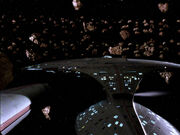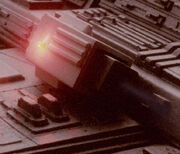m (Robot: Automated text replacement (-{{ShipClass +{{class)) |
m (Robot: Automated text replacement (-{{[Nn]Cwiki +{{mbeta)) Tag: apiedit |
||
| (One intermediate revision by one other user not shown) | |||
| Line 5: | Line 5: | ||
In [[spacedock]], all vessels were required to stay at maneuvering thrusters until they had cleared the outer space doors. ({{film|6}}) |
In [[spacedock]], all vessels were required to stay at maneuvering thrusters until they had cleared the outer space doors. ({{film|6}}) |
||
| − | All reaction-based technologies operated on the Newtonian principle of the "Law of Inertia": that |
+ | All reaction-based technologies operated on the Newtonian principle of the "Law of Inertia": that an object in motion will stay in motion unless acted upon by an external force. This was similar in some ways to [[impulse engine]] technologies and thrusters were sometimes called [[impulse thruster]]s or [[impulse jet]]s. ({{DS9|Rocks and Shoals}}; {{TNG|Encounter at Farpoint|Coming of Age}}) |
On a {{class|Constitution}} refit, the maneuvering thrusters were placed along the outer edges of the hull. ({{film|1}}) In [[Starfleet]] during the [[24th century]], maneuvering thrusters were part of the [[reaction control system]] and were also placed in similar positions. ({{VOY|The Cloud}}) These were typically placed in groups of four or "quads" on starships. ({{TNG|Final Mission}}; {{ENT|Future Tense}}) |
On a {{class|Constitution}} refit, the maneuvering thrusters were placed along the outer edges of the hull. ({{film|1}}) In [[Starfleet]] during the [[24th century]], maneuvering thrusters were part of the [[reaction control system]] and were also placed in similar positions. ({{VOY|The Cloud}}) These were typically placed in groups of four or "quads" on starships. ({{TNG|Final Mission}}; {{ENT|Future Tense}}) |
||
| Line 43: | Line 43: | ||
==External link== |
==External link== |
||
| − | * {{ |
+ | * {{mbeta}} |
[[Category:Propulsion technology]] |
[[Category:Propulsion technology]] |
||
Revision as of 05:11, 5 July 2015

The Enterprise-D using maneuvering thrusters

A thruster module from the Enterprise-D propels a stricken vessel
Maneuvering thrusters (often referred to as simply thrusters) were used by starships and other spacecraft to make precise movements in lieu of primary impulse or warp engine use. The thrusters were low-power reaction control jets that could be used for fine positional and attitudinal control, including station-keeping. They were most typically used in docking or similar maneuvers. (Star Trek: The Motion Picture; Star Trek; TNG: "Booby Trap")
In spacedock, all vessels were required to stay at maneuvering thrusters until they had cleared the outer space doors. (Star Trek VI: The Undiscovered Country)
All reaction-based technologies operated on the Newtonian principle of the "Law of Inertia": that an object in motion will stay in motion unless acted upon by an external force. This was similar in some ways to impulse engine technologies and thrusters were sometimes called impulse thrusters or impulse jets. (DS9: "Rocks and Shoals"; TNG: "Encounter at Farpoint", "Coming of Age")
On a Constitution-class refit, the maneuvering thrusters were placed along the outer edges of the hull. (Star Trek: The Motion Picture) In Starfleet during the 24th century, maneuvering thrusters were part of the reaction control system and were also placed in similar positions. (VOY: "The Cloud") These were typically placed in groups of four or "quads" on starships. (TNG: "Final Mission"; ENT: "Future Tense")
Appearances
- ENT:
- Movies:
- TNG:
- DS9:
- VOY:
- "The Cloud"
- "Elogium"
- "Thirty Days"
- "Think Tank"
External link
- Maneuvering thruster at Memory Beta, the wiki for licensed Star Trek works
